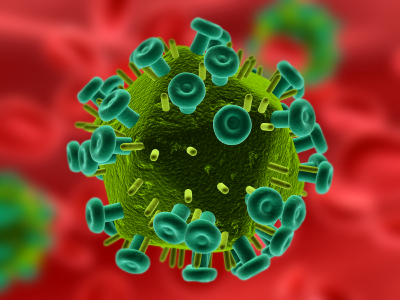Protein that destroys HIV discovered
August 23, 2010
Loyola University researchers have identified the key components of a protein called TRIM5a that destroys HIV in rhesus monkeys.
The finding could lead to new TRIM5a-based treatments that would knock out HIV in humans, said senior researcher Edward M. Campbell, PhD, of Loyola University Health System.
Campbell and colleagues report their findings in an article featured on the cover of the Sept. 15, 2010 issue of the journal Virology, now available online.
In 2004, other researchers reported that TRIM5a protects rhesus monkeys from HIV. The TRIM5a protein first latches on to a HIV virus, then other TRIM5a proteins gang up and destroy the virus.
Humans also have TRIM5a, but while the human version of TRIM5a protects against some viruses, it does not protect against HIV.
Researchers hope to turn TRIM5a into an effective therapeutic agent. But first they need to identify the components in TRIM5a that enable the protein to destroy viruses. “Scientists have been trying to develop antiviral therapies for only about 75 years,” Campbell said. “Evolution has been playing this game for millions of years, and it has identified a point of intervention that we still know very little about.”
TRIM5a consists of nearly 500 amino acid subunits. Loyola researchers have identified six 6 individual amino acids, located in a previously little-studied region of the TRIM5a protein, that are critical in the ability of the protein to inhibit viral infection. When these amino acids were altered in human cells, TRIM5a lost its ability to block HIV-1 infection. (The research was done on cell cultures; no rhesus monkeys were used in the study.)
By continuing to narrow their search, researchers hope to identify an amino acid, or combination of amino acids, that enable TRIM5a to destroy HIV. Once these critical amino acids are identified, it might be possible to genetically engineer TRIM5a to make it more effective in humans. Moreover, a better understanding of the underlying mechanism of action might enable the development of drugs that mimic TRIM5a action, Campbell said.
In their research, scientists used Loyola’s wide-field “deconvolution” microscope to observe how the amino acids they identified altered the behavior of TRIM5a. They attached fluorescent proteins to TRIM5a to, in effect, make it glow. In current studies, researchers are fluorescently labeling individual HIV viruses and measuring the microscopic interactions between HIV and TRIM5a.
More info: Loyola University Health System news
